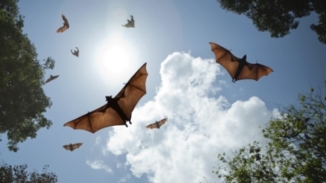
用回声数蝙蝠
Eavesdrop on Echolocation to Count Bats
用回声数蝙蝠
Researchers created a model that can accurately predict a cave's bat populations using audio alone. Christopher Intagliata reports.
研究人员开发出一种通过声呐准确测算洞穴中的蝙蝠总量的方法。
播音/撰文 克里斯托弗·因塔利亚塔
翻译 Meatle
审校 乔虹
"What you're listening to is what I like to call the beautiful chaos of the bat echolocation stream." Laura Kloepper, a bioacoustician at Saint Mary's College in Indiana. "So you're listening to the sound of probably a couple hundred bats emerging per second from the cave and there's a microphone that we have suspended in the middle of the bats to record the sounds. These are the echolocation sounds the bats make when they're flying and this is what they use to help navigate and find prey."
“你正听到的奇怪的声音是蝙蝠定位用的叫声。”来自印第安纳圣玛丽学院 (Saint Mary's College) 的生物声学家,劳拉·克劳帕 (Laura Kloepper)说,“而你现在听到的是我们在每秒大概有数百只蝙蝠出没的洞穴中录制的声音。我们在洞穴中央悬挂了一个麦克风,以此来录制这些蝙蝠在飞行时发出的用来辅助导航和捕猎的声波。”
The sounds—slowed down 10 times so we can hear them—were recorded at a network of lava tube caves in New Mexico. Kloepper and her colleagues camped out there to study how Mexican free-tailed bats echolocate in huge swarms without jamming each other's signals. And they noticed that the intensity of the “bleeps” seemed to correlate with the number of bats fluttering out of the cave. Meaning, maybe you could survey their populations with audio. "One night we were sitting around the campfire at our field site and we said, I wonder if this would actually work?"
刚才的声音片段是在新墨西哥州的熔岩隧道网络中录制的。这个声音片段的频率比原声减缓了10倍,以使其能被我们听见。克劳帕和她的同僚在洞穴附近扎营,以研究墨西哥无尾蝙蝠 (Mexican free-tailed bats) 如何在庞大的种群中进行回声定位而不受同伴的信号干扰。他们注意到了,声波中的“哔哔声”的强度仿佛与洞穴中忙乱的蝙蝠数量有关。这意味着可以通过分析声音信号来确定洞穴中的蝙蝠的人口。“一天晚上,我们都围坐在营地的营火旁边时,我们都在说:‘我想知道这个做法是否可行。’”
So they set up a new experiment, capturing audio and GoPro video at the cave site. They counted the bats in each video frame, and correlated that to the zips and zaps <
因此,他们搭建了新的实验,在录制洞穴中的声音的同时用运动摄像机录制视频。他们仔细清点了每个画面中出现的蝙蝠的数目,并与那些刺耳的录音联系起来,从而开发出一种测算模型。她们在另一个洞穴中试验她们的模型——结果表明仅仅通过声学结果就能估算出洞穴中的蝙蝠数目。该研究发表在《皇家学会开放科学杂志》 (Royal Society Open Science) 上。
"Historically what has been used to estimate bats has been photographic estimates, visual estimates, mark-recapture estimates, and those have been highly prone to bias." Newer technology, like thermal imaging cameras is accurate, but expensive. So at a time of epic bat mortality—due to, for example, the fungal white nose syndrome that’s wiping out bats in Canada and the U.S.—Kloepper says her method might be a cheap, reliable way to determine the most critical caves to save.
“以往点算蝙蝠数目的方法主要有摄像估算、目测估算、标记重捕估算,而这些方法都会相当容易产生偏差。”更新的技术,比如热成像摄像机,所产生的结果准确,但更为昂贵。因此,克劳帕认为在蝙蝠大量灭绝的时候——比如,真菌白鼻综合征(the fungal white nose syndrome)横扫北美大陆的时候——这种方法可能是一种便宜且可靠的确认最需要救助的洞窟的手段。
未经书面许可任何人不得复制或镜像
京ICP备11000850号-1
 京公网安备11010502039775号
京公网安备11010502039775号 信息网络传播视听节目许可证0111611号
国家科技基础条件平台

















